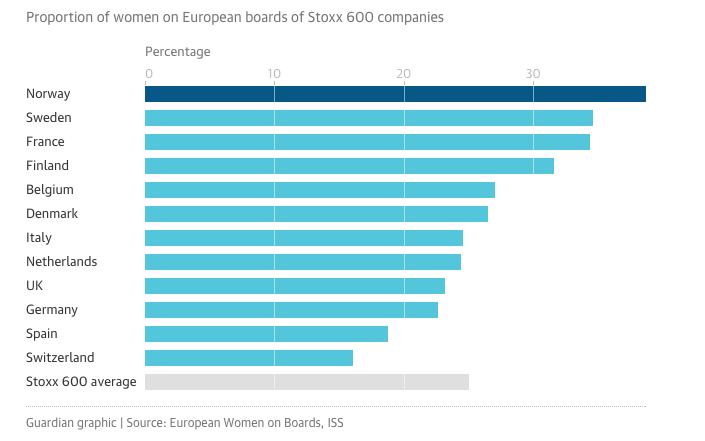Another week and another set of research that confirms, unfortunately, what we’ve all known to be true for decades: women lag behind men in board position hires. The
study by European Women on Boards (EWoB), a network that includes Britain’s Institute of Directors (IoD), assessed the boards of the 600 largest listed European companies – known as the Stoxx 600 – between 2011 and 2015. It reveals that women comprise less than a quarter of board positions in the UK. However, it also reveals that, across Europe, the proportion of women on boards has risen.
The study was published in the same week as a
report by the Economic Policy Institute (EPI), a Washington DC think tank, which demonstrates that the problem of gender disparity is not exclusive to more senior women. The report shows that, in the US, female graduates straight out of college earn around $9,000 less each year than their male peers.
Falling shortOn female board representation,
The Guardian’s Julia Kollewe notes that the disappointing 23.2% figure pushes the UK below many of its European peers: the average is 25%. Norway is a stand-out example, with women comprising 38.7% of boards.
While Norway unsurprisingly tops the list in the EWoB’s ranking of 12 leading European economies (see below), the UK comes in at ninth place, falling from eighth in 2011. “[The UK] nearly doubled female board representation from 12.2% [five years ago] … when the Coalition Government adopted a 25% target,” Kollewe says.
Below the UK is Germany, with 22.6% female board representation, Spain with 18.8% and Switzerland with 16%.
Kollewe goes on to quote Lady Barbara Judge, Chair of the IoD and a member of the EWoB advisory board: “British firms will have to reach the
Government’s ambition for a third of board posts to be held by women by 2020 if we are to have a chance of climbing toward the top of the European table.”
Highlighting the most dramatic increase, Kollewe says: “Italy achieved 24.6% female board representation last year, from only 4.2% in 2011.” Alongside Belgium, which tripled its proportion from 10% to 27%, Italy has introduced quotas for female board membership, which the report says “have led to quick boosts in numbers”.
The Guardian comment
 Clocking up the pace
Clocking up the paceJosie Cox reminds us that it’s not all bad news, in her blog for
The Wall Street Journal. According to the report: “The percentage of women who hold positions on large company boards in Europe has almost doubled over the last five years.”
But Cox turns the spotlight on the pace at which progress is being achieved. The UK’s lowly position on EWoB’s list, she says, comes “despite being one of the fastest growing [economies], and despite a push by businesses to bolster female representation”.
Cox also quotes Judge in her blog: “This research is an important reminder that, despite clear improvements in the last few years, there is still much more to be done to achieve a better gender balance on the boards of our large companies.”
Like Kollewe for
The Guardian, Cox argues that the rapid growth of female board representation in countries such as Italy is likely down to quotas being introduced.
While Norway has “a broad gender quota”, says Cox, Sweden and Finland, which both have a 30% female board membership and came second and fourth on the list, do not. This prompted the IoD to point out that “legislation has not been the only factor in driving increased female appointments”.
The Wall Street Journal blog
Stark and striking On the other end of the career spectrum, Catey Hill, writing for
MarketWatch, looks at how pay compares between recent female and male graduates in the US. “Even among [graduates], there is a large wage gap between the genders,” she says.
$9,000
On average, college-educated men aged 21–24 earn this much more than their female counterparts each year in the USCiting wages from a report out this week by the EPI, Hill says that in 2016, men aged between 21 and 24 with a college degree earn an average hourly rate of $20.94, while their female counterparts earn just $16.58. That amounts to a difference of about $9,000 a year.
Hill quotes Elise Gould, Senior Economist at EPI: “We’re comparing two groups both with college degrees [and] similar amounts of experience,” she says. “The difference is stark, it’s striking.”
And it seems the wage gap is growing. The report reveals that in the early 2000s college-educated young women made 92 cents for every dollar their male peers made – in 2016, it’s 79 cents.
Hill goes on to explore why this may be. “Some of this difference may … have to do with career choices. Men who major in engineering, for example, are more likely than women [engineering graduates] … to work as engineers.”
Hill then quotes another report,
Graduating to a pay gap, which said in 2012: “One year after graduation, a pay gap exists between women and men who majored in the same field. Among business majors, for example, women earned just over $38,000, while men earned just over $45,000.”
MarketWatch report
Seen a blog, news story or discussion online that you think might interest CISI members? Email joanna.lewin@wardour.co.uk